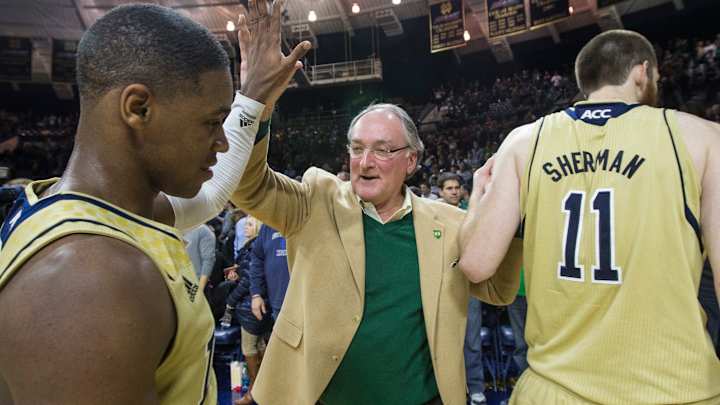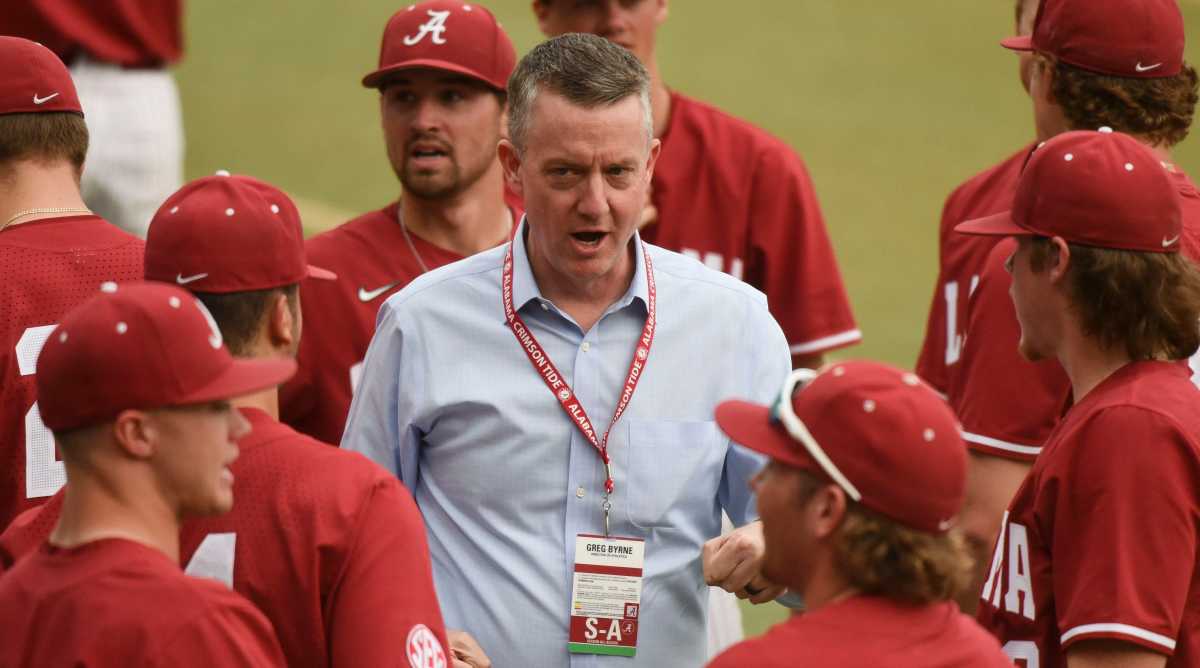Jack Swarbrick’s Retirement Points to a Dying Breed of Athletic Directors

On May 26, Iowa athletic director Gary Barta announced his retirement from a job he’s held since 2006. Two weeks later, Notre Dame announced that its AD, Jack Swarbrick, is stepping down in 2024 after 16 years on the job. And just like that, an increasingly impermanent profession saw its collective experience further diminished.
Consider how things once were at Iowa and Notre Dame. While Barta’s tenure seemed endless in Iowa City, it doesn’t measure up to Bump Elliott, who held the AD job from 1970–91. And Swarbrick is only going half as long as Edwin “Moose” Krause, who was AD from 1949–81 in South Bend. There are no Moose Krauses anymore.
Removing Barta and Swarbrick from the equation, the average current tenure for Power 5 conference athletic directors is 5.67 years. (That figure actually is boosted by the arrival of BYU as a Big 12 member come July 1; Tom Holmoe has been the AD there since 2005.) For the entirety of NCAA Division I FBS, the average is 4.99 years.
Using the FBS realignment upheaval of 2010–14 as a demarkation line, only six P5 ADs are still in the same jobs now that they were before then: Joe Castiglione at Oklahoma (since 1998); Mitch Barnhart at Kentucky (2002); Gene Smith at Ohio State (2005); Jamie Pollard at Iowa State (2005); Holmoe; and Swarbrick (for about six more months, anyway).

The days of popular former coaches moving into an AD position that functions as a cushy, semi-retirement gig are long gone. The modern AD jobs are big business, with big salaries and big staffs and big issues to address. They’re mostly filled by career administrators. And they rarely stay in one place forever.
“These jobs are hard to do, and hard to do for a long time,” says Chad Chatlos of Turnkey ZRG, who specializes in college executive searches. “If you can get a run at a very visible school for five to eight years and come out unscathed, you’re living a good life. Maybe four or five years is a good run.”
There are several reasons why the clock is always ticking on modern ADs:
1. Presidential turnover and executive board makeup.
If you think the churn at the AD level is fast, check out what is happening above them on the org chart. Chatlos, whose firm conducts university president and chancellor searches as well, says those jobs at larger schools are turning over about every three years.
The new CEO is apt to make his or her own senior staff changes upon arrival, or view the role of athletics differently. Turnover begets more turnover.
“Presidential turnover has accelerated so much,” Swarbrick says. “When your boss is changing, that adds an element of uncertainty to your situation.”
Then there are the boards of trustees. The vast majority of appointees for those boards are there because of their affection for a particular university. But they can also care too much.
“You’ve got to have people above you and around you who understand what your department is trying to do,” says Florida AD Scott Stricklin. “And who don’t read message boards.
“How does the board see its role? Our board takes pride in not meddling in athletics. They tend to take the approach of, ‘We support you and if you ever need anything, we’re here for you. But otherwise we’re going to leave you alone.’ If there’s someone else in authority who wants to do your job, you’re probably not going to last very long.”
2. With increased visibility comes increased scrutiny and, inevitably, criticism.
In his early 50s, Chatlos is hardly a grizzled old-timer. But he’s seen the athletic director profession change significantly in his time coordinating searches.
“When I started doing this, I was amazed how much athletic directors had on their plate and how little they were compensated, given how many hours they worked,” he says. “High-end athletic directors were making 400-500 grand while working their asses off—every weekend, every sport, always coming and always going.
“No one knew who your AD was. Fans knew who their football coach was and that was it. There was no internet, no bloggers. Over the past decade, to see how visible these guys are, the public scrutiny—everybody feels like they can reach out and touch you, scrutinize you. Fans, media, they want to get these guys fired every day. The visibility of it, now everything plays out up front.”
Current Wake Forest AD John Currie is credited with popularizing a phrase coined by search-firm executive Bob Beaudine, one that most of Currie’s colleagues understand and live by: “Athletic directors are never celebrated, only tolerated.”
However, there is a positive flip side to the publicity. Athletic directors who make good hires and whose teams win are upwardly mobile in an increasingly lucrative profession.
“If you do a good job, you’re going to get your ass recruited,” Chatlos says. “You’re going to get a lot of money thrown at you to go take another job.”
3. Your ride on the scandal cycle is almost inevitable.
College-age athletes are routinely prone to bad decisions that result in arrests, NCAA violations or academic misconduct. (So is the rest of the student body, but those missteps tend to get far less attention.) With increased revenue comes an increased focus on winning, which can lead to coaches compromising the usual talking points about “integrity” and “values” and “culture.” Boosters have never been more involved with athletes, and getting them to care about NCAA rules can be difficult.
Then there are the garden-variety workplace personnel issues that can lead to problems. With staffs bloating into the hundreds in most major athletic departments, stuff is bound to happen.
As the proverbial front porch of a university, both the good and bad headlines reflect on the school at large. Alabama, for instance, has enjoyed a surge in enrollment and a boost in academic selectivity during the Nick Saban Era of football excellence. But the school also has been buffeted by athletic scandal in 2023—from a basketball player charged with capital murder to an assistant athletic director charged with third-degree domestic violence to a baseball coach fired for his involvement with a gambler betting against the Crimson Tide.
“The repetitional consequences of athletics for a university has only increased,” Swarbrick says. “It’s never been inconsequential, but boy, it’s only gotten larger.”

4. You stop making new friends, only new enemies.
That’s a coaches’ saying, but it might be even more true of athletic directors in college towns. Most schools have a finite list of go-to donors, and hitting them up for every facility project can get old. Then there are the boosters who want input on coaching hires, staff changes, recruiting philosophy (looking at you, Auburn). Fans with inflated views of their favorite school’s place in the pecking order (within a conference or nationally) present a challenge in diplomacy.
“You’d better have some thick skin,” Chatlos says. “You’re going to be criticized, some people aren’t going to like you. If that affects you, you’re in the wrong business. The ability to hire really good people is critical. Put smart people around you who won’t just tell you, ‘You’re killing it.’“
In a business where every AD is one bad hire away from catching flak, it helps to have a reservoir of goodwill when the rough patches come. But winning is the best job security.
“There are times you have to navigate that are very challenging, but there is also a connection to being successful,” Castiglione says. “If the programs aren’t successful, it doesn’t matter how much one likes an individual. We’re still in a performance business.”
5. The industry is changing dramatically beneath every AD’s feet.
The pileup of relatively new issues administrators are confronting seems endless: athlete compensation and mobility, state and national legislation, potential employee status for athletes, funding for Olympic sports and so forth.
Among the new dilemmas facing ADs: competing with their own coaches for donor contributions. Coaches want NIL money flowing to collectives, while ADs are trying to bankroll scholarship funds, capitol projects, debt servicing and other costs that have traditionally been passed on in part to the fan base.
“The last couple of years have been some significant changes,” Castiglione says. “Being willing to evolve and adapt and thinking about change before change occurs. Governing boards change, CEOs of campus change, coaches change. An athletic director doesn’t necessarily get to dictate how long they stay at one place or another.”
With 25 years on the job, Castiglione is the extreme outlier in that category. He’s exceeded the current FBS job expectancy by two decades, and that average could continue dwindling.
Says Stricklin: “The old saying is, we’re all interim.”
